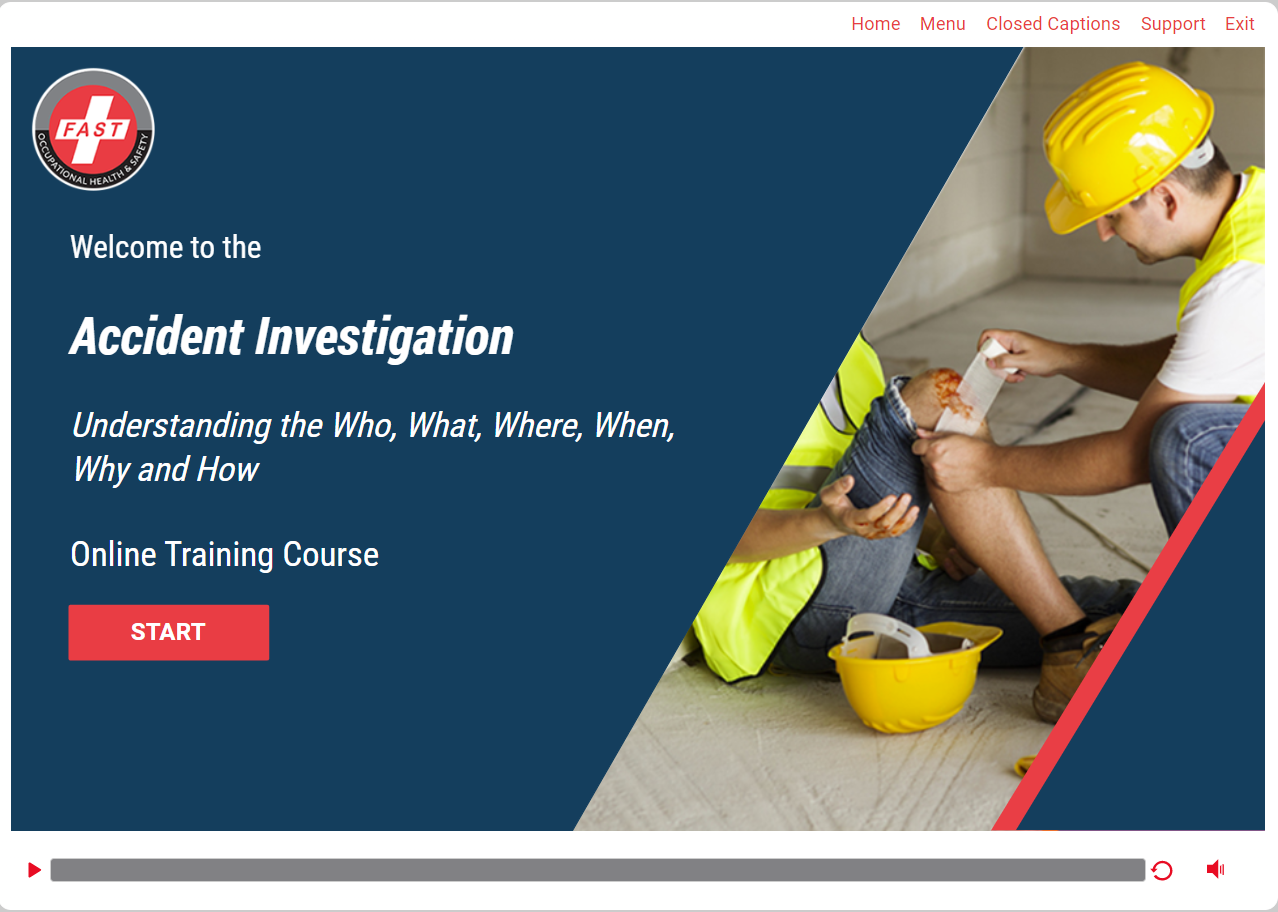
Accident Investigation Online Training Course
(E-SACC-E)
Introduction to Accident Investigation Online Training Course
Occupational Health and Safety (OHS) – Accident Investigation Training Online Program
Accident investigation training also helps you understand who, what, where, when, why, and how of accidents. This accident investigation training program gives you an understanding on how to investigate accidents.
Our AODA-compliant course is fully narrated and features detailed explanations, relevant visuals, and activities to reinforce learning. You’ll take a final test to assess your understanding. With the option to pause and bookmark your progress, you can learn at your own pace.
ACCIDENT INVESTIGATION TRAINING ONLINE COURSE OUTLINE
The course covers the following topics:
1. INTRODUCTION
This introductory chapter provides information and training regarding accident investigations. Also, learn about the benefits of accident investigations followed by who is responsible for various tasks throughout the process.
2. DUE DILIGENCE
Learn about all the circumstances in each case to protect the health and safety of all workers in an objective manner.
3. LEGISLATION
This chapter describes the clear guidelines relating to preservation established by the Occupational Health and Safety Act (OHSA). Also, learn all of the requirements that OHSA requires in a written report.
4. DEFINITIONS
In this chapter, learn about the precise definitions of the following along with the relevant images:
1. Definition #1 – Accident
2. Definition #2 – Incident
3. Definition #3 – Non Critical Injury
4. Definition #4 – Critical Injury
5. Definition #5 – Reportable Cases
6. Definition #6 – Lost Time Injuries
7. Definition #7 – Modified Duties
All the definitions are presented in a short yet informative manner to provide learners’ a clear gist of each and every term.
5. RESPONSIBILITIES
Learn about the responsibilities of the Joint Health and Safety Committee (JHSC) to investigate accidents. Also, learn about how accident reports are analysed followed by thorough follow-up.
6. INVESTIGATION PROCESS
The investigation process is a systematic and structured series of steps undertaken to uncover facts, analyze information, and derive conclusions related to a specific incident, situation, or concern. In this chapter, learn about the investigation process that is necessary to contribute information about any incident in the workplace. Here, learn the seven steps that are required for effective investigations of accidents/incidents.
7. TAKE IMMEDIATE ACTION
Taking immediate action involves promptly and decisively addressing a situation or issue as soon as it arises. This chapter describes various forms of immediate actions followed by important points to remember for an immediate action. Also, learn briefly about the following in this chapter along with relevant images:
1. Visiting the Scene
2. Take Control of the Situation
3. Care for the Injured
4. Secure the Area
5. Gather Names and Addresses of Eye Witnesses
8. GATHER EVIDENCE
Gathering evidence is the systematic and intentional process of collecting relevant information, data, or materials to support an investigation or inquiry. In this chapter, learn what things need to be taken into consideration while gathering evidence. Also, learn about the two different methods to gather evidence, along with some useful and important clues.
This chapter also focuses on the following:
1. Sketch the scene and take measurements
2. Sketching tips
3. Photographs
4. Photographs taking tips
5. Worksite inspections
6. Collecting information
7. Who to interview?
8. Categorizing witnesses
9. When to interview?
10. Interviewing the witness or victims
11. How to interview? Tips and Hints
The information presented in each and every sub-chapter are concise, accurate, and meaningful supported by relevant images.
9. PUT THE EVIDENCE IN ORDER
Putting the evidence in order refers to the systematic organization and arrangement of relevant information, facts, and data collected during an investigation. In this chapter, you will learn about how to gather all the facts to put in order to develop a mental picture of what happened. Also, in this chapter, you will learn about the following:
1. Who was involved?
2. What were the determining factors?
3. What procedures were in place at the time?
4. Where did the accident happen?
5. Why and How?
6. Root causes behind the problems
The information is presented in an easy-to-comprehend manner along with relevant images.
10. RECOMMENDATIONS FOR CORRECTIVE ACTION
Recommendations for corrective action are proposed strategies, interventions, or measures suggested following an analysis of an incident or problem. Learn about the recommendations for corrective action listed in this chapter.
11. FOLLOW UP
In this chapter, learn about the follow up that will help you make recommendations on subsequent incident investigations.
12. WRITE AN INVESTIGATIVE REPORT
Investigative report serves as a comprehensive analysis of the incident that occurred on [Date]. Learn how to write an investigative report by taking all the given points into consideration. The points are listed in this chapter.
13. THEORIES OF ACCIDENT CAUSATION
Accident causation theories are frameworks that seek to understand the factors and conditions leading to the occurrence of accidents in various environments. In this chapter, learn about the Heinrich theory and Iceberg theory that are represented using graphical diagrammatic representations followed by brief descriptions.
14. ANALYSIS
This chapter describes the analysis of an accident that will reveal three causal factors.
15. CAUSAL FACTORS
Causal factors refer to the underlying elements and conditions that contribute directly or indirectly to the occurrence of an incident or accident. Learn about the three causal factors i.e. direct causes, indirect causes, and basic causes. Each causal factor is described precisely in a separate chapter along with relevant images.
16. ACCIDENT INVESTIGATION
Learn about the preventive measures of an accident presented clearly using flow charts.
17. DETERMINING THE CAUSE
Determining the cause involves a systematic investigation to identify the fundamental factors and conditions that led to an incident. In this chapter, learn about the 5 factors that can be investigated to find the cause of the accident. The 5 factors for determining the cause include the following:
1. Material
2. Environment
3. Personnel
4. Management
5. Task
Each factor is described separately in different chapters with the support of relevant images.
18. NOTIFICATION
In this chapter, all the notifications including notice of death or critical injury, notice of accidents, workplace safety and insurance board are described.
19. FINAL THOUGHT
In this chapter, final thought of the module ‘Accident Investigation Training’ is provided as, “A thorough investigation of all accidents and incidents can prevent repeat injuries and possibly fatalities. Always remember it is a fact finding mission, not a place to lay blame.”
20. FINAL TEST
In the final test provided, questions are in the form of MCQs (Multiple choice questions). Learners have pass the test successfully in three attempts.
- Accident Investigation
- Download Certificate
Student Reviews
Feedback from students who have taken this course.

